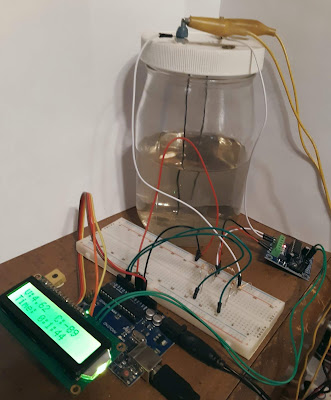I am working on some Arduino biometric designs perhaps for a new book. So far I have created the two line 1602 LCD display and now the Nokia 84x48 display. The Nokia display is more fun to work with since I can do a oscilloscope like display across the screen. I am working on writing code that works with both an Arduino UNO and with the ESP8266 or the "D1" board.
You can connect a NOKIA display easily using a header extender. You only need to connect five pins this way. The other two are power and ground and they use jumpers to 3.3 Volts and ground.
This is what the connections look like from above. Note that I have a 100 ohm resistor to power the LED back light connected across the two outside pins.
This is a close up picture of the display.
This is a link to the video of it operating.
https://youtu.be/BjQTGu81Pvo
Here is the code:
// NOKIA Heartbeat
// Hearteat BPM displays on line 1
// Scope Trace of Heartbeat displays on lower 1/2
// By Bob Davis in April 2020
#include <SPI.h>
#include <Adafruit_GFX.h>
#include <Adafruit_PCD8544.h>
Adafruit_PCD8544 display = Adafruit_PCD8544(D7, D6, D5, D3, D4);
// Variables
int pulsePin = A0; // Pulse Sensor on analog pin 0
int blinkPin = D13; // pin to blink led at each beat
int StartSample = 0;// Start time MS
int EndSample = 0; // End time MS
int rate[5]; // Array of samples in Milliseconds (MS)
int MS = 0; // Milliseconds between pulses
int BPM; // Beats Per Minute
int peak=800; // Typical Peak voltage
int valley=500; // Typical Minimum voltage
int thresh=250; // Trigger threashold
int sens=70; // Sensitivity to rise and fall of heartbeat
int Signal; // Incoming raw data from heart sensor
int ypos=0; // Trace Y axis
boolean Pulse = false; // "True" when heartbeat detected
int rateTotal = 0;
void setup(){
Serial.begin(9600);
display.begin();
display.setContrast(50);
display.clearDisplay(); // clears the screen and buffer
pinMode(blinkPin,OUTPUT); // pin to blink with heartbeat
pinMode(pulsePin,INPUT); // Configuring pin A0 as input
}
void loop(){
Signal = analogRead(pulsePin);
// Display values of BPM Signal on LCD
display.fillRect(0,0,80,20,WHITE); //Clear top
display.setCursor(0,0); // First line
display.println("BPM:");
display.setCursor(24,0); // First line
display.println(BPM);
display.setCursor(0,10); // First line
display.println("MS:");
display.setCursor(24,10); // First line
display.println(MS);
// Draw the trace of heartbeat
display.drawPixel(ypos,(Signal/10)-40,BLACK); // Bottom of LCD
ypos=ypos+1;
if (ypos>84) {
ypos=0;
display.clearDisplay(); // clears the screen and buffer
}
display.display(); // Update the screen
// Find peak, valley and detect change in direction
if (Signal > peak) peak=Signal; // Find peak
if (Signal < valley) valley=Signal; // Find valley
if (Pulse == false) thresh = (valley+sens); // look for rise
if (Pulse == true) thresh = (peak-sens); // look for fall
if ((Signal > thresh) && (Pulse == false)){ // Pulse Detected
Pulse = true; // set Pulse flag
digitalWrite(blinkPin,HIGH); // turn on pin 13 LED
}
if ((Signal < thresh) && (Pulse == true)){ // Pulse Finished
Pulse = false; // reset Pulse flag
digitalWrite(blinkPin,LOW); // turn off pin 13 LED
EndSample = millis();
MS = (EndSample-StartSample);
StartSample = millis();
// Reset peak and valley to center
valley = valley+((peak-valley)/2);
peak = valley+((peak-valley)/2);
// BPM = 60000/MS;
// Keep and average a running total
rate[5] = rate[4]; // Shift the oldest MS values
rate[4] = rate[3]; // Shift the oldest MS values
rate[3] = rate[2]; // Shift the oldest MS values
rate[2] = rate[1]; // Shift the oldest MS values
rate[1] = MS; // add the latest MS to array
rateTotal = (rate[1]+rate[2]+rate[3]+rate[4]+rate[5])/5; // Add up the MS values
BPM = 60000/rateTotal; // Beats in a minute is BPM
// display results on computer screen for troubleshooting.
Serial.print("Beats Per Min=");
Serial.print("\t");
Serial.print(BPM);
Serial.print("\t");
Serial.print(rate[1]);
Serial.println();
}
delay(10); // take a break
}






















































